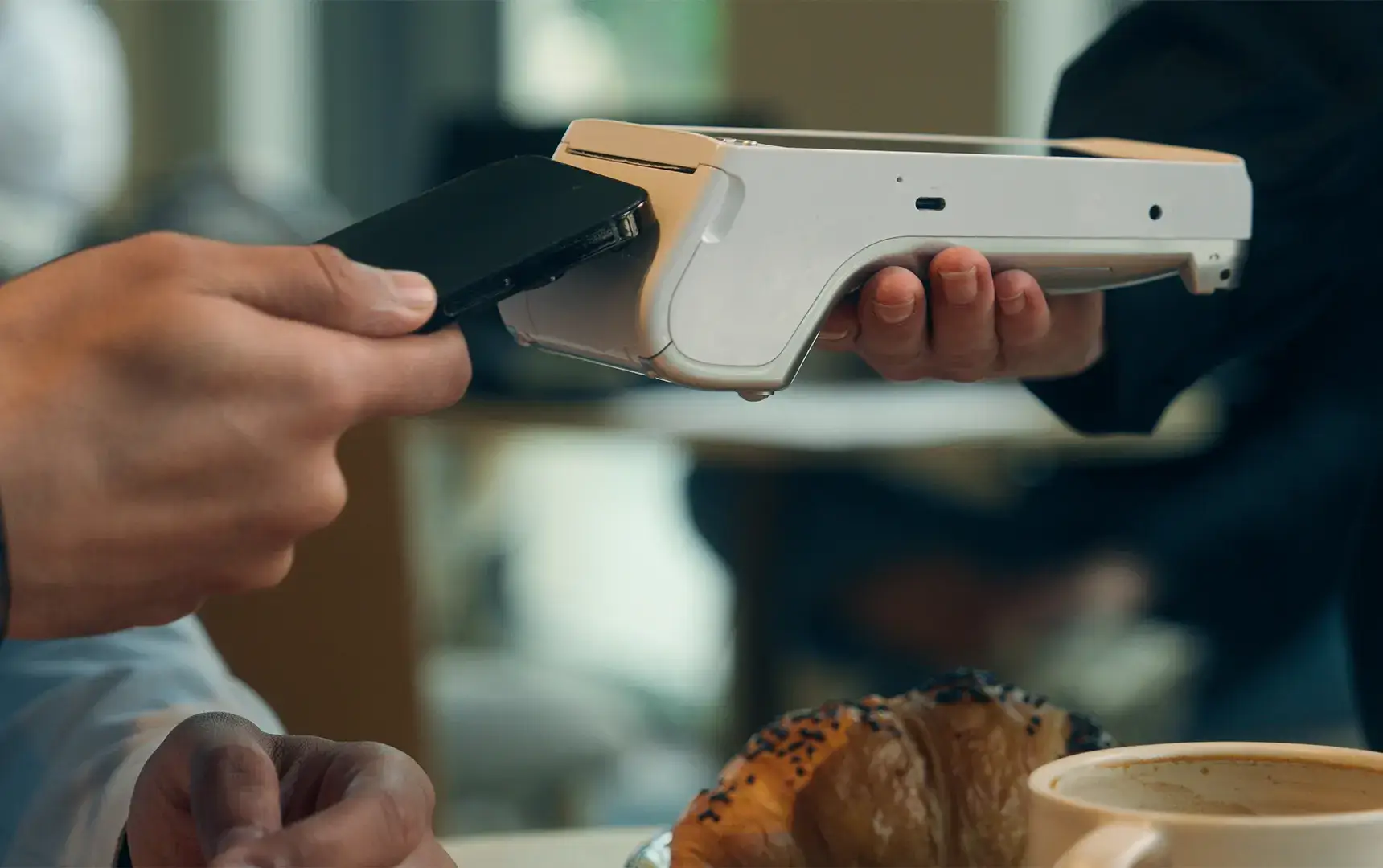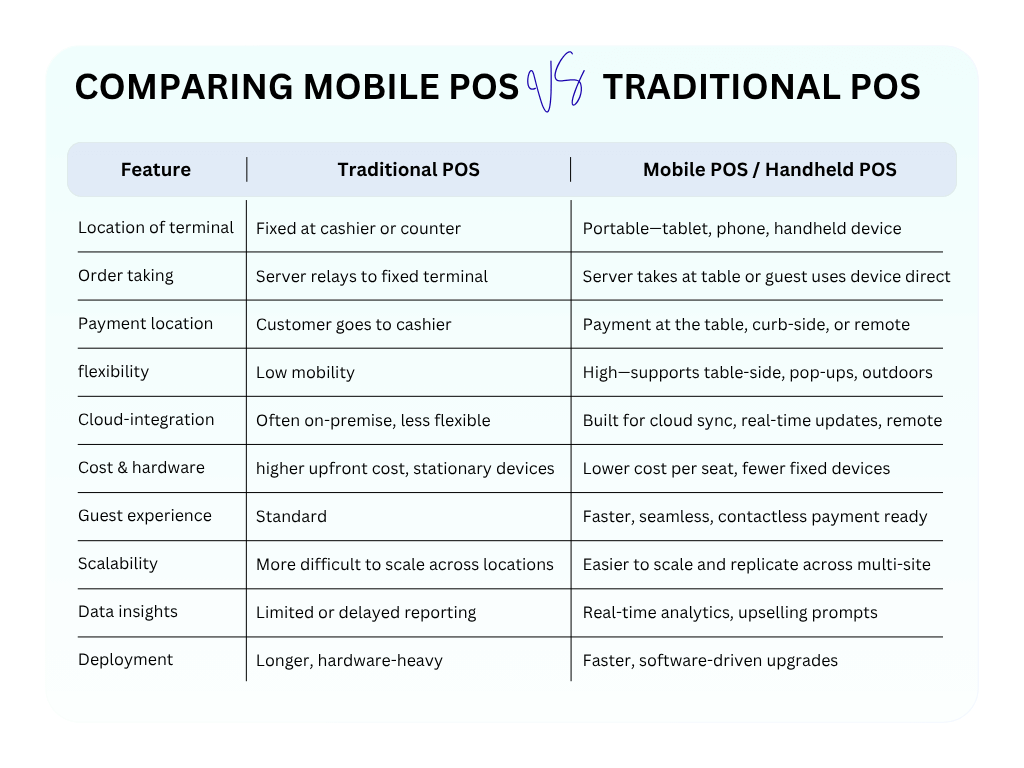Imagine this: a restaurant where servers take orders, process payments at the table, and update the kitchen instantly — while the owner tracks everything in real time, anytime, from anywhere. This is not a future vision; it’s what today’s mobile POS systems make possible.
Yet the reality for many restaurants is still harsh — around 17% close within the first year, and nearly 30% don’t make it past five years. Most fail not because of bad food, but because of poor visibility and control. With the right mobile POS solution, owners can see what’s happening across their business in one dashboard, make smarter decisions, reduce waste, and act before small issues become costly problems.

Why does this shift matter? Because diners expect speed, convenience, and digital payment options; labour costs and staffing shortages continue to challenge restaurant operators; and competition is fierce. A modern restaurant that relies solely on outdated fixed cash registers risks lagging behind. In this article you'll learn: what mobile POS terminals are, how they’re transforming operations, how they compare with traditional systems, common questions restaurants ask, a real-world example, and what’s next for restaurant technology.
A mobile POS terminal is a handheld or tablet-based device—or smartphone-based application—that enables order taking, payment processing, and real-time connection to the restaurant’s backend systems (inventory, kitchen, CRM). In contrast to a traditional static till or terminal at the cashier desk, mobile POS gives your staff the freedom to serve tableside, walk-in customers, or even outdoor/curb-side customers.
In restaurants, mobile POS (often called “handheld POS” or “mobile point of sale”) serves to streamline:
Why this matters: The market for restaurant-oriented POS terminals (both fixed and mobile) is growing strongly. For example, one research source estimates the restaurant POS terminals market will be USD 25.1 billion in 2025, reaching USD 49.3 billion by 2035. (Future Market Insights) Moreover, the mobile POS terminal market (across sectors including restaurants) is projected to grow at a CAGR of ~11.1% from 2023-2030. (Grand View Research)
For restaurants in 2025, the message is clear: mobile POS terminals are not just “nice to have”—they’re increasingly critical to meet diner expectations and compete.
Here’s how mobile POS is changing the game for restaurant operations across multiple fronts:
Here’s a comparison table to highlight how mobile POS differs from (and often improves upon) traditional POS systems:

Why are restaurants migrating toward mobile-first systems? Because they align with modern customer expectations (contactless payments, tableside service) and support operational efficiencies (mobility, faster turnarounds, real-time data). A report found in 2024 that 38% of restaurants now use POS systems that support both in-store and online orders in real time.
While traditional POS systems still serve many restaurants (especially large full-service operations with fixed counters), the flexibility and agility of mobile POS systems are compelling—especially for quick-service, casual dining, and hybrid delivery/take-out models.
What makes mobile POS essential for restaurants in 2025?
Mobile POS terminals are essential because they enable tableside ordering, contactless payments, and real-time data integration—key factors in restaurant efficiency and guest experience in 2025.
Is mobile POS secure for card payments?
Yes—modern mobile POS systems support encrypted transactions, tokenization, and comply with payment security standards, making mobile point of sale a safe option for restaurants.
Can small restaurants afford mobile POS terminals?
Absolutely—many mobile POS solutions are subscription-based, require minimal hardware (e.g., a tablet plus reader), and offer lower upfront cost than legacy fixed POS systems, making them accessible for small restaurants.
Do mobile POS systems work offline?
Some mobile POS solutions include offline mode to capture orders even when connectivity is lost; once connection restores, the data syncs—ensuring continuity of service and reliability in restaurants.
Let’s look at a case study of a mid-sized casual dining chain (“Ocean Breeze Grill”) which adopted mobile POS across its locations.

Initial challenges:
Implementation of mobile POS:
Measurable results:
Quote: “Switching to handheld mobile POS transformed our floor operation—servers spend more time with guests, and we’re handing tables faster with fewer mistakes,” said the General Manager of Ocean Breeze Grill.
This POS success story highlights how mobile restaurant technology can transform both guest experience and operational metrics.
Looking ahead to 2025 and beyond, how will mobile POS terminals evolve—and what should restaurant operators watch?
Mobile POS systems will increasingly incorporate AI to suggest upsells, optimise staffing, forecast menu items that might sell out, and even personalise guest offers. With integrated data from mobile POS, delivery apps and loyalty systems, restaurants can move beyond transaction capture to predictive operations.
Handheld POS devices will further integrate with kitchen display systems (KDS), online ordering platforms, curbside pickup modules, and third-party delivery marketplaces. The result: unified workflows—so a server, delivery prep and kitchen operate in sync.
Beyond tablets and smartphones, mobile POS may extend to wearable devices, glove-free voice ordering, table-embedded devices or even AR-assisted menus. Guests may use the mobile POS ecosystem themselves (via their smartphone) while the restaurant staff complements the experience.
Mobile POS will tie into guest profile data—past orders, preferences, dietary restrictions—and prompt staff or automate recommendations accordingly. For example, suggesting “based on your last visit you might like…” during tableside ordering.
As restaurants expand across locations and channels, cloud POS (and hybrid edge/cloud models) will provide scalability, remote management and resilience. According to data, cloud POS deployment is expected to grow at a CAGR over 9% from 2023-2030. (Grand View Research) Security continues to be a focus with contactless payments and mobile wallets growing rapidly. (Hotel Tech Report)
In short, mobile POS terminals will be at the heart of digital restaurant management—where front-of-house, back-of-house, delivery, and guest engagement merge into one intelligent platform. Restaurants that adopt early will be positioned to iterate faster, respond to market shifts (e.g., staffing challenges, consumer preferences) and maintain a competitive edge.
The transformation underway in restaurant operations is remarkable: mobile POS terminals are shifting the conversation from mere payment processing to full-scale operational intelligence. From faster table turns and fewer errors to real-time inventory updates and personalised guest experiences, the benefits are tangible.
With the global market for mobile POS (and restaurant POS systems more broadly) growing strongly, now is the time for restaurateurs to ask: Am I ready for mobile first? The earlier you adopt and optimise mobile POS terminals, the more you’ll gain in efficiency, guest satisfaction and operational agility.
Want to future-proof your restaurant? Explore how salesplay POS helps you adopt a mobile-first workflow free to start.
How is your restaurant preparing for the future of mobile POS? Share your thoughts below!